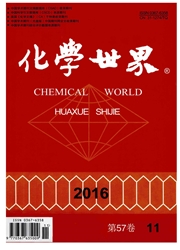

 中文摘要:
中文摘要:
以3-甲基-2-丁烯-1-氯为原料,合成3-甲基-2-丁烯-1-醇的催化水解工艺,利用气相色谱、红外光谱和核磁共振对所得产物进行了表征。通过正交试验讨论了催化剂种类、助催化剂种类、水解温度和水解液pH值对氯代烃的转化率和不饱和醇的选择性的影响。结果表明,最佳工艺条件为:n(氯代烃)∶n(CuCl)∶n(NaI)=1∶0.02∶0.02,水解温度为60℃,水解液pH=6。在此条件下,氯代烃的转化率达到97.83%,不饱和醇的选择性保持在94.19%。此外,研究了催化水解反应中副产物的产生机理及控制措施,提出了水解液循环利用过程中的催化效率保持的方法。
 英文摘要:
英文摘要:
3-Methyl-2-buten-1-ol was prepared from isopentenyl chloride by the catalytic hydrolysis method,and characterized by GC,IR and 1 H NMR.The effects of catalyst type,cocatalyst type,temperature and solution pH on the catalytic hydrolysis reaction were investigated by the orthogonal experiment method.The results indicated that the optimal conditions were:n(isopentenyl chloride)∶n(CuCl)∶n(NaI)=1∶0.02∶0.02,the temperature was 60 ℃,the solution pH was 6.Under the best conditions,the conversion of isopentenyl chloride was up to 97.83%,and the selectivity of 3-methyl-2-buten-1-ol was94.19%.Besides,the generating mechanism and the control measure of the byproduct,and the method of keeping catalytic efficiency in the recycle of hydrolysis solution was proposed.
 同期刊论文项目
同期刊论文项目
 同项目期刊论文
同项目期刊论文
 Aryl Aminoalcohols as Corrosion Inhibitors for Carbon Steel in Chloride-Contaminated Simulated Concr
Aryl Aminoalcohols as Corrosion Inhibitors for Carbon Steel in Chloride-Contaminated Simulated Concr 期刊信息
期刊信息
